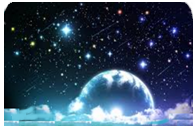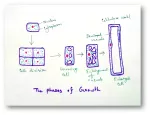Constellations
Groups of stars, which always stay together, seem to form some patterns or recognizable shapes in the sky and these groups of stars are known as constellations.
We can find some similarities of these patterns to certain animals and other figures.
Features of a few constellations are mentioned below:
The great plough:
Seven
bright stars constitute the The great plough. Indians known it as
Saptarshimandal. If we join those stars with imaginary lines it will take the
shape of a plough. Indian astronomers have named all these seven stars after
the names of seven great sages of ancient India. Their names are Kratu, Pulaha,
Pulasta, Atri, Angira, Bashistha and Morichi. If the first two stars, that is,
The great plough Kratu and Pulaha are joined with a straight line and then
extended towards far north, it will meet the big bright Pole star or the North
star there. Beside the star, named Bashistha, a smaller star is found which is
named as Arundhuti.
European astronomers added few more stars to this constellation and imagined it as a bear. They named it as the Great bear or the Ursa mazor.
Ursa minor:
At the left side of the Pole star, there is a smaller constellation, named Ursa minor. It has only six stars, arranged in the shape of a kite with a tail. Four stars are placed at four corners of the imaginary kite and two stars towards the Pole star, represent its tail The constellation is named as Ursa minor by the European astronomers. Indians known it as Laghu Saptarshimandal.
Orion:
From October to March, a prominent constellation appears in the sky. The arrangement of the stars appears like a warrior with a bow in his hand. Three stars make his belt at the waist. While other stars resemble a sword hanging from the belt. Indians known it as Kalpurus. The same constellation is known as Orion in Western countries.
The great dog
During winter months another constellation appears at the south-eastern side of the imaginary leg position of the Orion. It is composed of a few dim stars and a very bright star, called Lubdhak or Sirius. Joining these stars with imaginary lines we will find a figure of a big hunting dog as if it is following the Orion. Lubdhak or Sirius, situated at the head position of the great dog, is the second brightest star, seen from the Earth after the Sun. Indians call it Brihat Kukurmandal.
Cassiopeia:
At south-western side of the Pole star we will find five prominent stars. When we join those stars with imaginary straight lines, it will take the shape of English capital letter ‘W’. This is Cassiopeia. In clear sky we will find Cassiopeia at the right hand side of the Pole star, opposite to Ursa minor.
Evening star or Vesper:
In the evening we will find a very bright star near the western horizon. This is called Evening star. Indians call it Sandhyatara Before sunrise, the same star appears in the eastern sky. This is called Vesper. Indians call it Suktara. When we look at it for some time, we will find that it is not twinkling but is glowing steadily. This is because Vesper or Evening star is not a star. It is the Venus, a planet of the solar system. Like the Earth, it also revolves round the Sun. So we find it in different positions in the sky at different times.
From Constellations to HOME PAGE
Recent Articles
-
Explain about Growth in Plants |Definition of Growth & Differentiation
Feb 27, 25 02:07 PM
Growth is a permanent increase in length or volume of an organism that brought upon by an increase in its dimensions due to synthesis of new protoplasmic material. -
Definition of Respiratory Quotient | calculation | Application | Plant
Dec 02, 24 12:09 AM
Definition of respiration quotient- the ratio of the carbon-dioxide evolved to that of the oxygen consumed by a cell, tissue, plants or animals in a given time is called respiratory quotient. It is us… -
Amphibolic Pathway | Definition | Examples | Pentose Phosphate Pathway
Jun 06, 24 10:40 AM
Definition of amphibolic pathway- Amphibolic pathway is a biochemical pathway where anabolism and catabolism are both combined together. Examples of amphibolic pathway- there are different biochemical… -
Respiratory Balance Sheet | TCA Cycle | ATP Consumption Process
Feb 18, 24 01:56 PM
The major component that produced during the photosynthesis is Glucose which is further metabolised by the different metabolic pathways like glycolysis, Krebs cycle, TCA cycle and produces energy whic… -
Electron Transport System and Oxidative Phosphorylation | ETC |Diagram
Feb 04, 24 01:57 PM
It is also called ETC. Electron transfer means the process where one electron relocates from one atom to the other atom. Definition of electron transport chain - The biological process where a chains…





New! Comments
Have your say about what you just read! Leave me a comment in the box below.